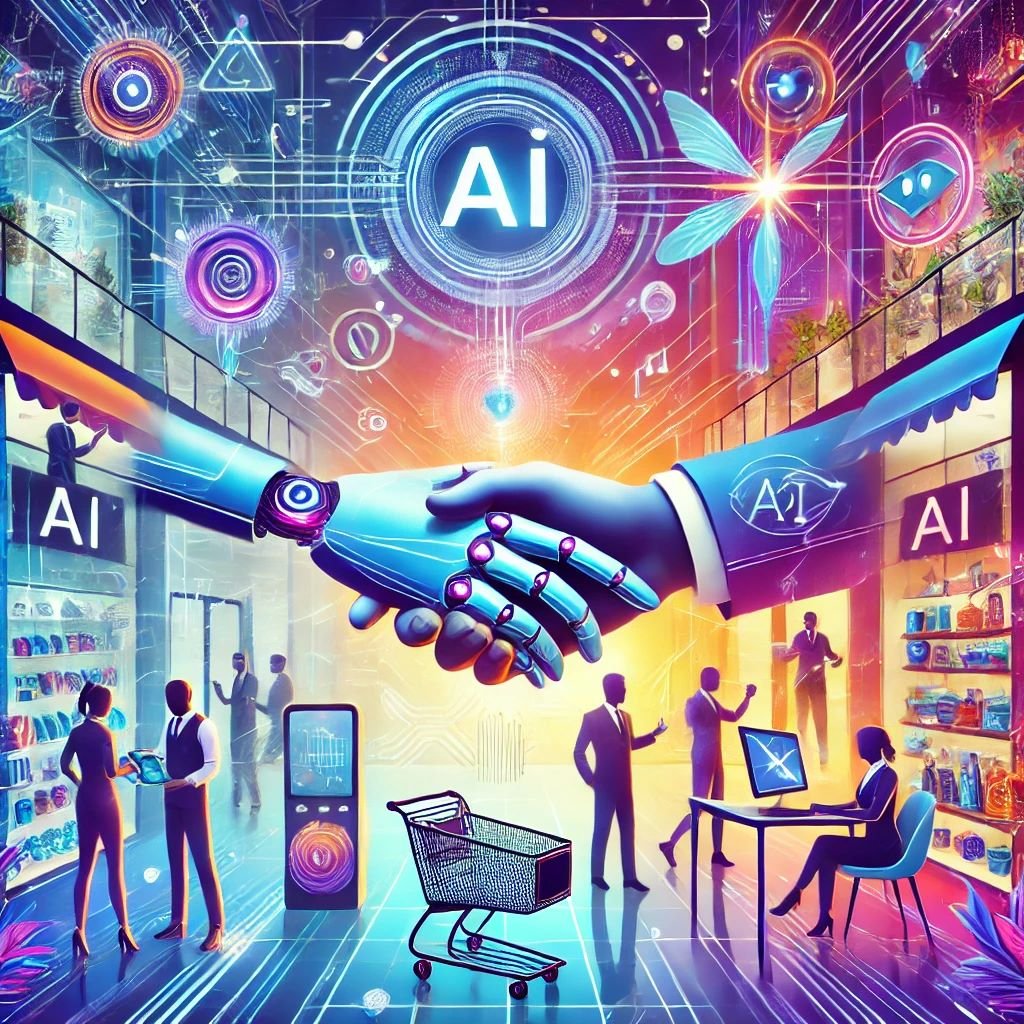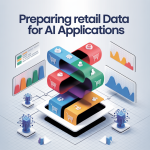
Upcoming AI Trends in Retail: Transforming the Industry
Artificial intelligence (AI) is rapidly evolving, offering groundbreaking opportunities to enhance retail operations, customer experiences, and decision-making.
Here are the key upcoming AI trends that will shape the future of retail.
1. Hyper-Personalization
AI will deliver more precise and context-aware personalization at every stage of the customer journey.
Key Developments:
- Real-Time Personalization: AI adjusts product recommendations, marketing messages, and website content in real-time based on customer behavior.
- Emotion AI: Recognizes customer emotions through text, voice, or facial cues to tailor interactions.
- Dynamic Loyalty Programs: AI analyzes shopping patterns to customize rewards and offers.
Example: A shopper browsing for outdoor gear online receives tailored product suggestions based on their location’s weather conditions.
2. Autonomous Retail Stores
AI will drive the rise of cashier-less and fully autonomous stores, providing seamless shopping experiences.
Key Features:
- Computer Vision: Tracks items customers pick off shelves for automated billing.
- AI-Powered Shelf Management: Monitors stock levels and restocks automatically.
- Behavior Analytics: Analyzes customer movements to optimize store layouts and product placements.
Example: Stores like Amazon Go are pioneers in this trend, offering grab-and-go shopping experiences.
3. Voice Commerce Growth
Voice-enabled shopping will become a standard feature in retail, allowing customers to interact with brands through smart devices.
Trends to Watch:
- Voice Assistants for Shopping: AI-powered systems like Alexa or Google Assistant will handle product searches, order placements, and reorders.
- Conversational Commerce: Combines voice and chat interfaces to guide customers through purchases.
- Multimodal AI: Integrates voice with visual displays for richer interactions.
Example: A customer can reorder groceries by asking their smart fridge to create a shopping list based on current inventory.
4. Advanced AI-Powered Supply Chains
AI will enhance supply chain resilience and efficiency, particularly in an era of global disruptions.
Advancements:
- Predictive Analytics: Anticipates demand fluctuations and potential disruptions to minimize risks.
- Robotic Process Automation (RPA): Automates repetitive tasks like order tracking and invoice processing.
- Smart Logistics: AI optimizes routes, reduces delivery times, and cuts fuel costs.
Example: AI predicts a supply chain delay due to weather conditions and reroutes shipments to ensure timely delivery.
5. Immersive Shopping Experiences with AR and VR
AI will combine with augmented reality (AR) and virtual reality (VR) to redefine how customers shop.
Upcoming Features:
- Virtual Try-Ons: Customers can use AR to try on clothes, accessories, or makeup.
- VR Stores: Fully immersive virtual environments allow customers to browse and shop from anywhere.
- In-Store AR Guides: Mobile apps offer real-time navigation and product information.
Example: A shopper uses their smartphone to visualize how a sofa will look in their living room before purchasing.
6. AI-Enhanced Marketing Automation
AI will make retail marketing more targeted, efficient, and engaging.
Innovations:
- Real-Time Campaign Optimization: AI dynamically adjusts campaigns based on live performance metrics.
- Hyper-Localized Marketing: AI delivers promotions based on a customer’s exact location and preferences.
- Interactive AI Ads: Conversational AI will create engaging, real-time dialogues within advertisements.
Example: A location-based app sends a personalized discount offer to a shopper passing by a retail store.
7. Sustainable Retail Practices with AI
AI will play a pivotal role in helping retailers achieve sustainability goals.
Key Developments:
- Eco-Friendly Supply Chains: AI optimizes sourcing and logistics to reduce carbon footprints.
- Waste Reduction: Predictive analytics helps minimize overstock and food waste in grocery stores.
- Consumer Transparency: AI tracks and reports the environmental impact of products to customers.
Example: A fashion retailer uses AI to recommend sustainable fabric options to shoppers and highlights the carbon footprint of each product.
8. Predictive Customer Service
AI will anticipate customer needs, solving issues before they arise.
Features to Expect:
- Proactive Notifications: AI informs customers of potential delays or product availability issues.
- Anticipatory Assistance: Virtual assistants provide solutions based on customer history and behavior.
- Sentiment Analysis: AI detects frustration in customer queries and escalates them to human agents when necessary.
Example: A customer is notified about a delay in their order and offered a discount automatically through an AI-powered system.
9. AI-Augmented Workforce
Retail employees will collaborate with AI tools to improve efficiency and customer interactions.
Future Applications:
- AI-Driven Training: Virtual assistants provide real-time guidance and onboarding for new hires.
- Task Management: AI assigns tasks based on employee skills, workload, and availability.
- Real-Time Insights: AI equips employees with customer data to deliver personalized service.
Example: A store associate uses an AI app to access a customer’s purchase history and suggest complementary products.
10. Emotion AI in Retail
AI systems will interpret customer emotions to refine marketing, product recommendations, and customer service.
Emerging Capabilities:
- Facial Recognition: Detects mood changes during in-store interactions to personalize service.
- Sentiment Analysis: Monitors customer feedback on social media and reviews to adjust strategies.
- Empathetic Chatbots: Respond with human-like understanding to emotional queries.
Example: An AI system detects frustration in a chatbot interaction and immediately transfers the customer to a human agent for better resolution.
Upcoming AI trends in retail are set to redefine the industry by focusing on personalization, automation, sustainability, and immersive experiences.
Retailers that adopt these cutting-edge technologies will not only streamline operations but also create engaging, customer-centric experiences that drive loyalty and growth.
The future of retail lies in embracing AI as a strategic partner in innovation.
Building a Tech-Savvy Retail Team: Strategies for Success
As technology becomes integral to the retail industry, having a tech-savvy team is no longer optional—it’s essential.
A workforce proficient in leveraging technology can drive efficiency, improve customer experiences, and keep your business competitive.
Here’s how to build and nurture a tech-savvy retail team.
1. Define the Role of Technology in Your Retail Operations
Before building a tech-savvy team, it’s important to clarify how technology supports your retail goals.
- Key Questions to Address:
- What tech tools are essential for daily operations (e.g., POS systems, inventory management software)?
- How does technology enhance customer experience (e.g., chatbots, AR/VR solutions)?
- Which emerging technologies align with your future goals?
Example: A clothing retailer might prioritize training in inventory management software and AR-enabled fitting room tools.
2. Assess Current Tech Skills and Identify Gaps
Understanding the existing skill levels of your team helps determine training needs.
- Steps to Assess Skills:
- Conduct surveys or assessments to gauge familiarity with tools.
- Identify tech-savvy employees who can act as internal mentors.
- Review performance data to spot inefficiencies tied to tech usage.
Example: If team members struggle with mobile POS systems, prioritize training in that area.
3. Offer Comprehensive Tech Training Programs
A. Onboarding for New Hires
Include tech training in your onboarding process to ensure new employees are comfortable with essential tools.
- What to Cover:
- POS and CRM systems.
- Inventory management platforms.
- Customer-facing technologies like kiosks or AR apps.
B. Continuous Learning Opportunities
Provide ongoing training to keep the team updated on new tools and best practices.
- Examples:
- Online courses through platforms like Udemy or Coursera.
- In-house workshops with tech experts.
- Vendor-led sessions for specialized software.
Tip: Use gamification to make training engaging and rewarding.
4. Foster a Culture of Tech Adoption
Encourage employees to embrace technology by showing its benefits and supporting its use.
- Strategies:
- Celebrate tech-driven successes, such as improved efficiency or sales growth.
- Encourage feedback on tools to involve employees in tech decisions.
- Reward employees who excel at leveraging technology.
Example: Recognize a store associate who uses customer data effectively to drive sales with a “Tech Champion” award.
5. Leverage User-Friendly Technology
Choose tools that are intuitive and require minimal training.
- Considerations:
- Simplicity: Tools should align with employees’ workflows without adding complexity.
- Integration: Choose platforms that integrate seamlessly with existing systems.
- Support: Opt for vendors with robust customer support and training resources.
Example: Implement a chatbot powered by ChatGPT for customer inquiries to reduce manual workload and streamline communication.
6. Provide Cross-Functional Tech Exposure
Encourage employees to understand and use technologies across different areas of retail.
- Why It Matters:
- Enhances adaptability and problem-solving skills.
- Builds a more versatile team ready for future challenges.
- How to Implement:
- Rotate team members through roles involving inventory, customer service, and marketing tools.
Example: A marketing associate gains exposure to inventory data analytics, enabling better promotional strategies.
7. Build a Collaborative Environment
Facilitate knowledge-sharing among team members to promote a tech-savvy culture.
- Methods:
- Create a central knowledge base for tech FAQs and tips.
- Encourage employees to share experiences and best practices in team meetings.
- Pair tech-savvy employees with less experienced peers for mentorship.
Example: Use Slack or Microsoft Teams to host a “Tech Tips” channel where employees can share insights and troubleshoot together.
8. Measure and Reward Tech Proficiency
Track team progress and recognize achievements in adopting and leveraging technology.
- Metrics to Monitor:
- Usage rates of key tools.
- Efficiency improvements (e.g., faster checkout times).
- Employee satisfaction with tech tools.
- Rewards for Excellence:
- Bonuses or incentives for tech-driven contributions.
- Public recognition for innovative tech use.
Example: Reward a team that significantly reduces inventory errors using AI-powered tools.
9. Embrace Emerging Technologies
Prepare your team to adopt future technologies like AI, IoT, and AR/VR by fostering a mindset of continuous innovation.
- Steps to Future-Proof Your Team:
- Stay informed about emerging trends and their retail applications.
- Pilot new technologies with select team members to evaluate impact.
- Build partnerships with tech vendors for early access to innovations.
Example: Train staff to use AR-enabled tools for virtual try-ons, enhancing the in-store experience.
10. Partner with Technology Providers
Collaborate with vendors and consultants to provide specialized training and support.
- Benefits of Vendor Partnerships:
- Access to tailored training programs.
- Expert advice on maximizing tool usage.
- Early insights into new features or updates.
Example: Partner with an AI chatbot provider to train your team in configuring and managing customer-facing bots.
Building a tech-savvy retail team requires a strategic approach to training, culture, and tool selection.
By investing in continuous learning, fostering collaboration, and embracing emerging technologies, retailers can equip their workforce to thrive in a tech-driven industry.
A well-prepared, tech-enabled team isn’t just a competitive advantage—it’s the foundation of future retail success.
Long-Term Strategies for Integrating AI in Retail
Integrating artificial intelligence (AI) into retail operations requires a forward-thinking approach that aligns with long-term business goals.
To maximize the benefits of AI, retailers must prioritize scalable solutions, foster a culture of innovation, and ensure ethical and sustainable practices.
Here are strategic steps to successfully integrate AI into your retail business for the long term.
1. Develop a Comprehensive AI Strategy
A well-defined AI roadmap ensures alignment between AI initiatives and business objectives.
Steps to Build Your AI Strategy:
- Assess Current Needs: Identify areas where AI can provide immediate and measurable value, such as inventory management, customer personalization, or predictive analytics.
- Define Objectives: Set clear goals for AI implementation, such as cost reduction, improved efficiency, or enhanced customer experiences.
- Prioritize Projects: Start with small-scale pilots in high-impact areas, then scale gradually.
Example: A grocery chain focuses first on AI-driven demand forecasting to reduce food waste before expanding to personalized customer promotions.
2. Invest in Scalable Infrastructure
AI adoption requires robust technological infrastructure to support growing data needs and advanced tools.
Key Components of Scalable Infrastructure:
- Cloud Computing: Provides flexible, scalable resources for AI applications.
- Data Management Systems: Ensure seamless collection, integration, and analysis of data from all channels.
- Edge AI: Deploy AI locally in stores or warehouses to enable real-time decision-making.
Example: Retailers like Walmart use cloud-based platforms to analyze data across thousands of locations simultaneously.
3. Build a Data-Centric Culture
Data is the backbone of AI. Ensuring data quality and promoting a data-driven mindset are critical for AI success.
Best Practices:
- Centralize Data: Consolidate data from e-commerce, in-store, and supply chain systems into a unified platform.
- Ensure Data Accuracy: Use data validation and cleaning processes to maintain high-quality datasets.
- Promote Data Literacy: Train employees to interpret and use AI-driven insights in their roles.
Example: An AI-powered CRM platform provides sales teams with actionable customer insights, such as purchasing patterns and preferences.
4. Focus on Omnichannel Integration
Long-term AI strategies should enhance the seamless integration of online and offline retail experiences.
Key Omnichannel Applications:
- Inventory Synchronization: Use AI to provide real-time stock visibility across all channels.
- Personalized Customer Journeys: Leverage AI to deliver consistent, tailored interactions, whether online or in-store.
- Unified Loyalty Programs: Reward customers for interactions across channels, using AI to customize offers.
Example: A retailer implements AI to ensure that customers can order online and pick up in-store while receiving relevant product recommendations during both interactions.
5. Prioritize Employee Training and Change Management
AI adoption requires equipping your workforce with the skills and knowledge to use AI tools effectively.
Strategies for Training and Support:
- AI Literacy Programs: Offer workshops on AI basics and practical applications in retail.
- Continuous Learning: Provide access to online courses and certifications on AI-related topics.
- Involve Employees in Implementation: Encourage staff feedback during pilot projects to increase buy-in.
Example: A fashion retailer trains sales associates to use AI-powered styling tools to provide personalized recommendations to shoppers.
6. Embrace Ethical AI Practices
Long-term success with AI depends on maintaining customer trust and adhering to ethical guidelines.
Core Principles of Ethical AI:
- Transparency: Clearly communicate how AI is used and how customer data is handled.
- Fairness: Ensure AI models do not perpetuate bias in recommendations, pricing, or hiring.
- Privacy Compliance: Follow regulations like GDPR and CCPA to protect customer data.
Example: A retailer using AI for dynamic pricing ensures that price adjustments are fair and transparent, avoiding discrimination against specific customer groups.
7. Collaborate with AI Partners and Vendors
Partnering with AI experts helps retailers stay ahead of technological advancements.
Benefits of Collaboration:
- Access to Expertise: Gain insights from vendors specializing in AI for retail.
- Accelerated Implementation: Leverage pre-built AI solutions to reduce development time.
- Ongoing Support: Ensure regular updates and maintenance for AI tools.
Example: Partnering with an AI chatbot provider like ChatGPT enables seamless integration of conversational AI for customer service.
8. Foster Innovation with Emerging Technologies
AI will continue to evolve, and staying competitive requires experimenting with the latest innovations.
Emerging AI Trends to Explore:
- Generative AI: Use AI tools to create personalized marketing content, such as product descriptions and ad campaigns.
- Computer Vision: Implement AI-powered systems for visual inventory checks and customer behavior analysis.
- Voice AI: Enhance customer interactions with voice-activated shopping and support.
Example: A grocery retailer adopts computer vision to automatically track shelf stock levels, reducing manual inventory checks.
9. Measure ROI and Adjust Strategies
Track the performance of AI initiatives over time to ensure they deliver value and meet business goals.
Metrics to Monitor:
- Operational Efficiency: Measure time and cost savings achieved through automation.
- Customer Satisfaction: Use Net Promoter Scores (NPS) or customer feedback surveys.
- Revenue Growth: Track increases in sales driven by AI-powered recommendations or marketing.
Example: A retailer tracks conversion rates after implementing AI-driven personalized emails, refining the strategy based on performance data.
10. Plan for Sustainability and Longevity
Integrating AI for the long term involves aligning with sustainability goals and ensuring adaptability to future changes.
Sustainable AI Practices:
- Energy Efficiency: Use AI to optimize energy consumption in stores and warehouses.
- Waste Reduction: Leverage predictive analytics to minimize overstock and reduce spoilage.
- Circular Economy Support: AI can track and optimize product recycling and resale efforts.
Example: AI predicts demand for seasonal items, helping a retailer reduce unsold inventory and lower environmental impact.
Integrating AI into retail operations requires a thoughtful, long-term approach that prioritizes scalability, ethics, and continuous innovation.
By investing in robust infrastructure, fostering a tech-savvy workforce, and leveraging emerging technologies, retailers can future-proof their businesses and thrive in a competitive, AI-driven marketplace.
Success lies in viewing AI not just as a tool but as a strategic partner in transforming the retail experience.


